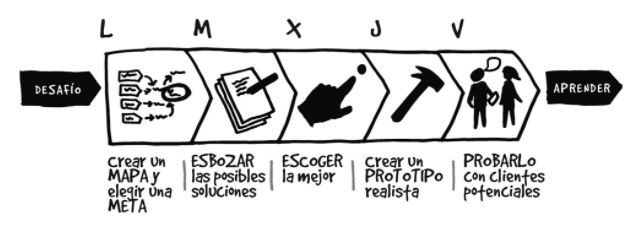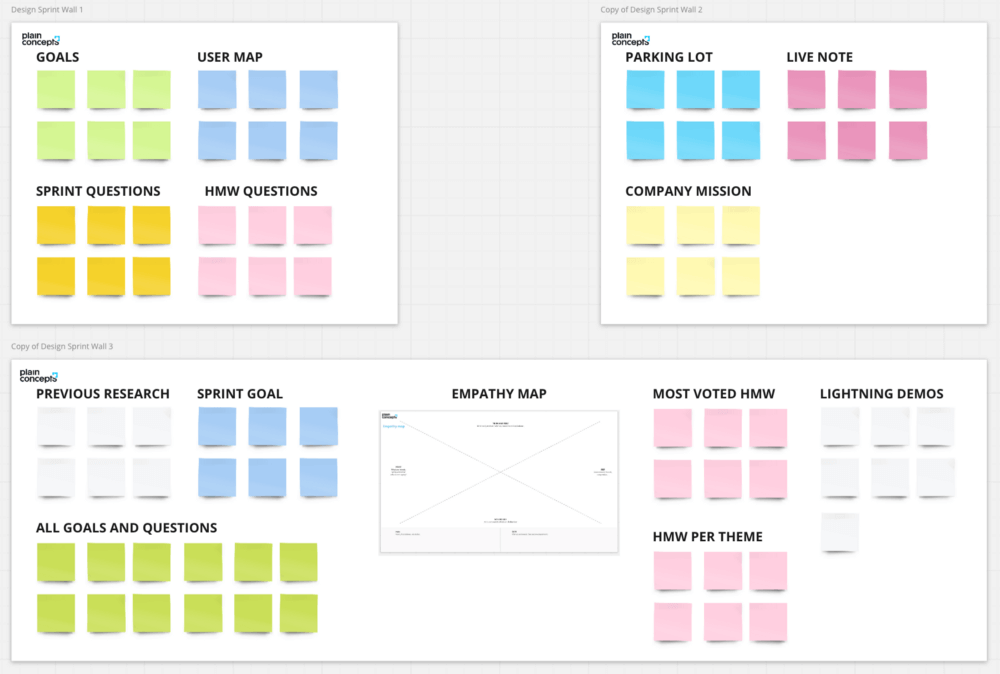What is design sprint and what type of projects is it suitable for
What is a Design Sprint?
Design Sprint allows us to build and test a prototype in just five days. There are many startups and tech companies that use it before making decisions about new products.
Design Sprint process
 The person who created Design Sprint is Jake Knapp. In his book, he defines himself as a process geek and explains how he had tried many problem-solving techniques over the years, but only when working at Google, he faced two different projects, one for the design of the priority mailbox in Gmail and another one for the design of a video conferencing web app, where he realised that the ideas had flowed better than in other creative processes and the main reasons were that they had more time to develop the ideas individually and the deadlines were so tight that they forced them to be focused. With these two ingredients, individual work, and little execution time, he began to design what would be a new way of working that he called Sprint.
The person who created Design Sprint is Jake Knapp. In his book, he defines himself as a process geek and explains how he had tried many problem-solving techniques over the years, but only when working at Google, he faced two different projects, one for the design of the priority mailbox in Gmail and another one for the design of a video conferencing web app, where he realised that the ideas had flowed better than in other creative processes and the main reasons were that they had more time to develop the ideas individually and the deadlines were so tight that they forced them to be focused. With these two ingredients, individual work, and little execution time, he began to design what would be a new way of working that he called Sprint.
Knapp realized that sprints worked. Ideas were built, tested, and launched and most of them used to succeed. He sees sprints as a way to solve big problems, during the process a great volume of work is done at a high speed and it is also fun. As its creator and many people who have participated in Design Sprints say, you have to experience it for yourself to understand it thoroughly.
What type of projects is a Design Sprint most suitable for?
 Design Sprint is especially suitable for those projects that, due to their complexity, are a challenge in themselves, because it helps to focus, prioritize ideas and begin to build a prototype quickly without making large financial investments.
Design Sprint is especially suitable for those projects that, due to their complexity, are a challenge in themselves, because it helps to focus, prioritize ideas and begin to build a prototype quickly without making large financial investments.
It is very interesting to apply it in those projects that are high risk because their development involves making a large investment or because there is not enough time. Design Sprint can be an excellent starting point that provides information on the feasibility of the project in just five days.
Its application is also ideal for projects that do not make progress or are stuck, DS helps to solve the problems that have caused the project to stop and can give it a new push and start working from a new perspective.
Design Sprint ideation
It is not recommended to have too many people participating in a Design Sprint. The ideal number would be 7 participants. If there are more, there is a risk of wasting time with debates that could stop the progress at the appropriate speed. During the five days of development of the Design Sprint, all stakeholders must be present, each one solving the problem of the area they dominate and willing to answer any doubts that may arise from other team members. The roles involved are the following:

The Sprintmaster
Is the person who does all works on the pre-work, organising the dynamics, and will guide the team throughout the five days of the Design Sprint. Once the sprint is over, the facilitator will be in charge of documenting all the findings and information from the workshop.
The decider
Is the person who will make and prioritise the decisions. Although all participants in the Design Sprint have the ability to vote, the decision-maker will have the “star vote”, and will be responsible for the final decision made.
The team
Whenever possible, should be formed by people from the most relevant branches or departments in the business ( customer service/sales….).
Design Sprint phases

Monday
We start by presenting the challenge or problem to be solved and the day is dedicated to mapping it out, understanding it, asking questions (HMW), and conducting interviews with experts in the field who can solve all those doubts. By the end of the first day, the main objective to work on and the strategy to follow will be already decided.
The Design Sprint can also be carried out remotely, if that is the case, the boards from the first day would look like these.

Tuesday
The next day is dedicated to provide solutions for the objective set on the previous day. We will seek inspiration and share it with the team through “Lightning Demos”. We will make sketches, starting critical thinking, and leaving aesthetics aside. Finally, we will design the wireframes based on those sketches.
Wednesday
We will create an “art museum” in which we will present all the wireframes designed the day before and we will decide which prototype will be the one chosen among all those proposed. Once we select the idea that will be carried out, we will continue the storyboard in which we will place the user who will use said service.
Thursday
We will spend the day creating a prototype as realistic as possible so that we can test it during the next day with users.
Friday
We will carry out the tests with users. Jacob Nielsen explains in this article that, it does not contribute much to run tests with more than five users, the norm is that after the fifth user, same errors are repeated, the same type of difficulties are found and the contributions are very similar. Therefore, running a smaller number of tests provides enough information to be able to iterate and the budget will also be lower.
Resources to plan and conduct a Design Sprint
Trello Template to organize the five days of the workshop.
Miro Template created by the design consultancy JustMad, it also includes a very useful checklist to mark tasks solved during the sprint.
Template designed by Wayfair with the explanation of the entire process from beginning to end with very interesting tips to facilitate Design Sprint sessions.
Summarizing…

When a Design Sprint ends most of its participants are both exhausted and proud of all the work they have done during the five days. Usually, the general feeling is that great teamwork has been achieved; all participants forget about the hierarchies during the sessions, contributing equally and walking in the same direction.
Running a Design Sprint is usually tremendously motivating both individually and as a team. It also opens up the minds of participants, obtaining very inspiring ideas.
Configuration ACCEPT Reject all
Privacy Overview
More information in the Cookies Policy.
| Cookie | Duration | Description |
|---|---|---|
| __cfduid | 1 year | The cookie is used by cdn services like CloudFare to identify individual clients behind a shared IP address and apply security settings on a per-client basis. It does not correspond to any user ID in the web application and does not store any personally identifiable information. |
| __cfduid | 29 days 23 hours 59 minutes | The cookie is used by cdn services like CloudFare to identify individual clients behind a shared IP address and apply security settings on a per-client basis. It does not correspond to any user ID in the web application and does not store any personally identifiable information. |
| __cfduid | 1 year | The cookie is used by cdn services like CloudFare to identify individual clients behind a shared IP address and apply security settings on a per-client basis. It does not correspond to any user ID in the web application and does not store any personally identifiable information. |
| __cfduid | 29 days 23 hours 59 minutes | The cookie is used by cdn services like CloudFare to identify individual clients behind a shared IP address and apply security settings on a per-client basis. It does not correspond to any user ID in the web application and does not store any personally identifiable information. |
| _ga | 1 year | This cookie is installed by Google Analytics. The cookie is used to calculate visitor, session, campaign data and keep track of site usage for the site's analytics report. The cookies store information anonymously and assign a randomly generated number to identify unique visitors. |
| _ga | 1 year | This cookie is installed by Google Analytics. The cookie is used to calculate visitor, session, campaign data and keep track of site usage for the site's analytics report. The cookies store information anonymously and assign a randomly generated number to identify unique visitors. |
| _ga | 1 year | This cookie is installed by Google Analytics. The cookie is used to calculate visitor, session, campaign data and keep track of site usage for the site's analytics report. The cookies store information anonymously and assign a randomly generated number to identify unique visitors. |
| _ga | 1 year | This cookie is installed by Google Analytics. The cookie is used to calculate visitor, session, campaign data and keep track of site usage for the site's analytics report. The cookies store information anonymously and assign a randomly generated number to identify unique visitors. |
| _gat_UA-326213-2 | 1 year | No description |
| _gat_UA-326213-2 | 1 year | No description |
| _gat_UA-326213-2 | 1 year | No description |
| _gat_UA-326213-2 | 1 year | No description |
| _gid | 1 year | This cookie is installed by Google Analytics. The cookie is used to store information of how visitors use a website and helps in creating an analytics report of how the wbsite is doing. The data collected including the number visitors, the source where they have come from, and the pages viisted in an anonymous form. |
| _gid | 1 year | This cookie is installed by Google Analytics. The cookie is used to store information of how visitors use a website and helps in creating an analytics report of how the wbsite is doing. The data collected including the number visitors, the source where they have come from, and the pages viisted in an anonymous form. |
| _gid | 1 year | This cookie is installed by Google Analytics. The cookie is used to store information of how visitors use a website and helps in creating an analytics report of how the wbsite is doing. The data collected including the number visitors, the source where they have come from, and the pages viisted in an anonymous form. |
| _gid | 1 year | This cookie is installed by Google Analytics. The cookie is used to store information of how visitors use a website and helps in creating an analytics report of how the wbsite is doing. The data collected including the number visitors, the source where they have come from, and the pages viisted in an anonymous form. |
| attributionCookie | session | No description |
| cookielawinfo-checkbox-analytics | 1 year | Set by the GDPR Cookie Consent plugin, this cookie is used to record the user consent for the cookies in the "Analytics" category . |
| cookielawinfo-checkbox-necessary | 1 year | This cookie is set by GDPR Cookie Consent plugin. The cookies is used to store the user consent for the cookies in the category "Necessary". |
| cookielawinfo-checkbox-necessary | 11 months | This cookie is set by GDPR Cookie Consent plugin. The cookies is used to store the user consent for the cookies in the category "Necessary". |
| cookielawinfo-checkbox-necessary | 11 months | This cookie is set by GDPR Cookie Consent plugin. The cookies is used to store the user consent for the cookies in the category "Necessary". |
| cookielawinfo-checkbox-necessary | 1 year | This cookie is set by GDPR Cookie Consent plugin. The cookies is used to store the user consent for the cookies in the category "Necessary". |
| cookielawinfo-checkbox-non-necessary | 11 months | This cookie is set by GDPR Cookie Consent plugin. The cookies is used to store the user consent for the cookies in the category "Non Necessary". |
| cookielawinfo-checkbox-non-necessary | 11 months | This cookie is set by GDPR Cookie Consent plugin. The cookies is used to store the user consent for the cookies in the category "Non Necessary". |
| cookielawinfo-checkbox-non-necessary | 11 months | This cookie is set by GDPR Cookie Consent plugin. The cookies is used to store the user consent for the cookies in the category "Non Necessary". |
| cookielawinfo-checkbox-non-necessary | 1 year | This cookie is set by GDPR Cookie Consent plugin. The cookies is used to store the user consent for the cookies in the category "Non Necessary". |
| cookielawinfo-checkbox-performance | 1 year | Set by the GDPR Cookie Consent plugin, this cookie is used to store the user consent for cookies in the category "Performance". |
| cppro-ft | 1 year | No description |
| cppro-ft | 7 years 1 months 12 days 23 hours 59 minutes | No description |
| cppro-ft | 7 years 1 months 12 days 23 hours 59 minutes | No description |
| cppro-ft | 1 year | No description |
| cppro-ft-style | 1 year | No description |
| cppro-ft-style | 1 year | No description |
| cppro-ft-style | session | No description |
| cppro-ft-style | session | No description |
| cppro-ft-style-temp | 23 hours 59 minutes | No description |
| cppro-ft-style-temp | 23 hours 59 minutes | No description |
| cppro-ft-style-temp | 23 hours 59 minutes | No description |
| cppro-ft-style-temp | 1 year | No description |
| i18n | 10 years | No description available. |
| IE-jwt | 62 years 6 months 9 days 9 hours | No description |
| IE-LANG_CODE | 62 years 6 months 9 days 9 hours | No description |
| IE-set_country | 62 years 6 months 9 days 9 hours | No description |
| JSESSIONID | session | The JSESSIONID cookie is used by New Relic to store a session identifier so that New Relic can monitor session counts for an application. |
| viewed_cookie_policy | 11 months | The cookie is set by the GDPR Cookie Consent plugin and is used to store whether or not user has consented to the use of cookies. It does not store any personal data. |
| viewed_cookie_policy | 1 year | The cookie is set by the GDPR Cookie Consent plugin and is used to store whether or not user has consented to the use of cookies. It does not store any personal data. |
| viewed_cookie_policy | 1 year | The cookie is set by the GDPR Cookie Consent plugin and is used to store whether or not user has consented to the use of cookies. It does not store any personal data. |
| viewed_cookie_policy | 11 months | The cookie is set by the GDPR Cookie Consent plugin and is used to store whether or not user has consented to the use of cookies. It does not store any personal data. |
| VISITOR_INFO1_LIVE | 5 months 27 days | A cookie set by YouTube to measure bandwidth that determines whether the user gets the new or old player interface. |
| wmc | 9 years 11 months 30 days 11 hours 59 minutes | No description |
| Cookie | Duration | Description |
|---|---|---|
| __cf_bm | 30 minutes | This cookie, set by Cloudflare, is used to support Cloudflare Bot Management. |
| sp_landing | 1 day | The sp_landing is set by Spotify to implement audio content from Spotify on the website and also registers information on user interaction related to the audio content. |
| sp_t | 1 year | The sp_t cookie is set by Spotify to implement audio content from Spotify on the website and also registers information on user interaction related to the audio content. |
| Cookie | Duration | Description |
|---|---|---|
| _hjAbsoluteSessionInProgress | 1 year | No description |
| _hjAbsoluteSessionInProgress | 1 year | No description |
| _hjAbsoluteSessionInProgress | 1 year | No description |
| _hjAbsoluteSessionInProgress | 1 year | No description |
| _hjFirstSeen | 29 minutes | No description |
| _hjFirstSeen | 29 minutes | No description |
| _hjFirstSeen | 29 minutes | No description |
| _hjFirstSeen | 1 year | No description |
| _hjid | 11 months 29 days 23 hours 59 minutes | This cookie is set by Hotjar. This cookie is set when the customer first lands on a page with the Hotjar script. It is used to persist the random user ID, unique to that site on the browser. This ensures that behavior in subsequent visits to the same site will be attributed to the same user ID. |
| _hjid | 11 months 29 days 23 hours 59 minutes | This cookie is set by Hotjar. This cookie is set when the customer first lands on a page with the Hotjar script. It is used to persist the random user ID, unique to that site on the browser. This ensures that behavior in subsequent visits to the same site will be attributed to the same user ID. |
| _hjid | 1 year | This cookie is set by Hotjar. This cookie is set when the customer first lands on a page with the Hotjar script. It is used to persist the random user ID, unique to that site on the browser. This ensures that behavior in subsequent visits to the same site will be attributed to the same user ID. |
| _hjid | 1 year | This cookie is set by Hotjar. This cookie is set when the customer first lands on a page with the Hotjar script. It is used to persist the random user ID, unique to that site on the browser. This ensures that behavior in subsequent visits to the same site will be attributed to the same user ID. |
| _hjIncludedInPageviewSample | 1 year | No description |
| _hjIncludedInPageviewSample | 1 year | No description |
| _hjIncludedInPageviewSample | 1 year | No description |
| _hjIncludedInPageviewSample | 1 year | No description |
| _hjSession_1776154 | session | No description |
| _hjSessionUser_1776154 | session | No description |
| _hjTLDTest | 1 year | No description |
| _hjTLDTest | 1 year | No description |
| _hjTLDTest | session | No description |
| _hjTLDTest | session | No description |
| _lfa_test_cookie_stored | past | No description |
| Cookie | Duration | Description |
|---|---|---|
| loglevel | never | No description available. |
| prism_90878714 | 1 month | No description |
| redirectFacebook | 2 minutes | No description |
| YSC | session | YSC cookie is set by Youtube and is used to track the views of embedded videos on Youtube pages. |
| yt-remote-connected-devices | never | YouTube sets this cookie to store the video preferences of the user using embedded YouTube video. |
| yt-remote-device-id | never | YouTube sets this cookie to store the video preferences of the user using embedded YouTube video. |
| yt.innertube::nextId | never | This cookie, set by YouTube, registers a unique ID to store data on what videos from YouTube the user has seen. |
| yt.innertube::requests | never | This cookie, set by YouTube, registers a unique ID to store data on what videos from YouTube the user has seen. |
